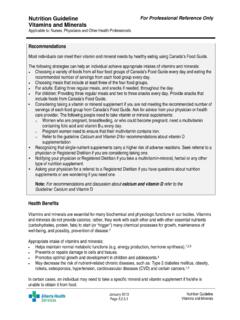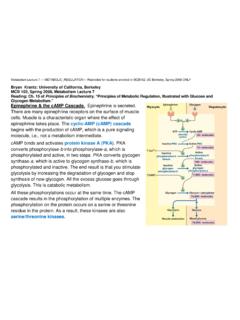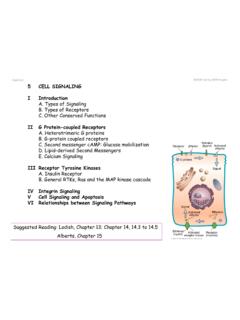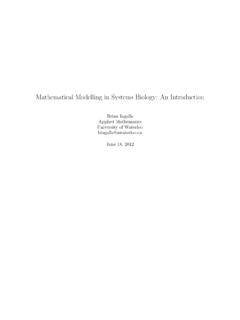Transcription of Glycolysis
1 CHEM464 /Medh, Glycolysis1 Glycolysis The Glycolytic pathway describes the oxidation of glucose to pyruvate with the generation of ATP and NADH It is also called as the Embden-Meyerhof Pathway Glycolysis is a universal pathway; present in all organisms: from yeast to mammals. In eukaryotes, Glycolysis takes place in the cytosol Glycolysis is anaerobic; it does not require oxygen In the presence of O2, pyruvate is further oxidized to CO2. In the absence of O2, pyruvate can be fermented to lactate or ethanol. Net Reaction: Glucose + 2 NAD++ 2 Pi + 2 ADP = 2 pyruvate + 2 ATP + 2 NADH + 2 H2 OThe 3 stages of Glycolysis Stage 1is the investment stage. 2 mols of ATP are consumed for each mol of glucose Glucose is converted to fructose-1,6-bisphosphate. Glucose is trapped inside the cell and at the same time converted to an unstable form that can be readily cleaved into 3-carbon units.
2 In stage 2fructose-1,6-bisphosphate is cleaved into 2 3-carbon units of glycerladehyde-3-phosphate. Stage 3is the harvesting stage. 4 mols of ATP and 2 molsof NADH are gained from each initial mol of glucose. This ATP is a result of substrate-level phosphorylation Glyceraldehyde-3-phosphate is oxidized to pyruvateCHEM464 /Medh, Glycolysis2 Step-wise reactions of Glycolysis Reaction 1: Phosphorylation of glucose to glucose-6 phosphate. This reaction requires energy and so it is coupled to the hydrolysis of ATP to ADP and Pi. Enzyme: hexokinase. It has a low Km for glucose; thus, once glucose enters the cell, it gets phosphorylated. This step is irreversible. So the glucose gets trapped inside the cell. (Glucose transporters transport only free glucose, not phosphorylated glucose) Reaction 2: Isomerization of glucose-6-phosphate to fructose 6-phosphate. The aldose sugar is converted into the keto isoform.
3 Enzyme: phosphoglucomutase. This is a reversible reaction. The fructose-6-phosphate is quickly consumed and the forward reaction is favored. Reaction 3: is another kinase reaction. Phosphorylation of the hydroxyl group on C1 forming fructose-1,6- bisphosphate. Enzyme: phosphofructokinase. This allosteric enzyme regulates the pace of Glycolysis . Reaction is coupled to the hydrolysis of an ATP to ADP and Pi. This is the second irreversible reaction of the glycolytic pathway. Reaction 4: fructose-1,6-bisphosphate is split into 2 3-carbon molecules, one aldehyde and one ketone: dihyroxyacetonephosphate (DHAP) and glyceraldehyde 3-phosphate (GAP). The enzyme is aldolase. Reaction 5: DHAP and GAP are isomers of each other and can readily inter-convert by the action of the enzyme triose-phosphate isomerase. GAP is a substrate for the next step in Glycolysis so all of the DHAP is eventually depleted. So, 2 molecules of GAP are formed from each molecule of glucoseStep-wise reactions of Glycolysis (continued)CHEM464 /Medh, Glycolysis3 Upto this step, 2 molecules of ATP were required for each molecule of glucose being oxidized The remaining steps release enough energy to shift the balance sheet to the positive side.
4 This part of the glycolyticpathway is called as the payoff orharvest stage. Since there are 2 GAP molecules generated from each glucose, each of the remaining reactions occur twice for each glucose molecule being oxidized. Reaction 6: GAP is dehydrogenated by the enzyme glyceraldehyde 3-phosphate dehydrogenase (GAPDH). In the process, NAD+is reduced to NADH + H+from NAD. Oxidation is coupled to the phosphorylation of the C1 carbon. The product is 1,3-bisphosphoglycerate. Step-wise reactions of Glycolysis (continued) Reaction 7: BPG has a mixed anhydride, a high energy bond, at C1. This high energy bond is hydrolyzed to a carboxylic acid and the energy released is used to generate ATP from ADP. Product: 3-phosphoglycerate. Enzyme: phosphoglycerate kinase. Reaction 8: The phosphate shifts from C3 to C2 to form 2-phosphoglycerate. Enzyme:phosphoglycerate mutase. Reaction 9: Dehydration catalyzed by enolase (a lyase). A water molecule is removed to form phosphoenolpyruvatewhich has a double bond between C2 and C3.
5 Reaction 10: Enolphosphate is a high energy bond. It is hydrolyzed to form the enolic form of pyruvate with the synthesis of ATP. The irreversible reaction is catalyzed by the enzyme pyruvate kinase. Enol pyruvate quickly changes to keto pyruvate which is far more stable. Step-wise reactions of Glycolysis (continued)CHEM464 /Medh, Glycolysis4 Glycolysis : Energy balance sheet Hexokinase: - 1 ATP Phosphofructokinase: -1 ATP GAPDH: +2 NADH Phsophoglycerate kinase: +2 ATP Pyruvate kinase: +2 ATPT otal/ molecule of glucose: +2 ATP, +2 NADHFate of Pyruvate NADH is formed from NAD+during Glycolysis . The redox balance of the cell has to be maintained for further cycles of Glycolysis to continue. NAD+can be regenerated by one of the following reactions /pathways: Pyruvate is converted to lactate Pyruvate is converted to ethanol In the presence of O2, NAD+is regenerated by ETC.
6 Pyruvate is converted to acetyl CoA which enters TCA cycle and gets completely oxidized to CO2. CHEM464 /Medh, Glycolysis5 Lactate Fermentation Formation of lactate catalyzed by lactate dehydrogenase: CH3-CO-COOH + NADH + H+ CH3-CHOH-COOH + NAD+ In highly active muscle, there is anaerobic glycolysisbecause the supply of O2cannot keep up with the demand for ATP. Lactate builds up causing a drop in pH which inactivates glycolytic enzymes . End result is energy deprivation and cell death; the symptoms being pain and fatigue of the muscle. Lactate is transported to the liver where it can be reconverted to pyruvate by the LDH reverse reactionEthanol fermentation Formation of ethanol catalyzed by 2 enzymes Pyruvate decarboxylase catalyzes the first irreversible reaction to form acetaldehyde:CH3-CO-COOH CH3-CHO + CO2 Acetaldehyde is reduced by alcohol dehydogenase is a reversible reaction:CH3-CHO + NADH + H+ CH3CH2OH + NAD+ Ethanol fermentation is used during wine-making CHEM464 /Medh, Glycolysis6 Fructoseis phosphorylated by fructokinase (liver) or hexokinase(adipose) on the 1 or 6 positions resp.
7 Fructose-6-phosphate is an intermediate of Glycolysis . Fructose-1-phosphate is acted upon by an aldolase-like enz that gives DHAP and glyceraldehyde. DHAP is a Glycolysis intermediate and glyceraldehyde can be phosphorylated to glyceraldehyde-3-P. Glycerolis phosphorylated to G-3-P which is then converted to glyceraldehyde 3 phosphate. Galactosehas a slightly complicated multi-step pathway for conversion to glucose-1-phosphate. gal gal-1-P UDP-gal UDP-glc glc-1-P. If this pathway is disrupted because of defect in one or more enzinvolved in the conversion of gal to glc-1-P, then galactoseaccumulates in the blood and the subject suffers from galactosemiawhich is a genetic disorder, an inborn error of of other sugars into glycolysisRegulation of GlycolysisEnzyme ActivatorHexokinaseAMP/ADPP hosphofructokinaseAMP/ADP, Fructose-2,6-bisphosphatePyruvte kinaseAMP/ADPF ructose-1,6-bisphosphateEnzyme InhibitorHexokinaseGlucose-6-phosphatePh osphofructokinaseATP, CitratePyruvate kinaseATP, Acetyl CoA, AlanineCHEM464 /Medh, Glycolysis7 Regulation of Hexokinase Hexokinase catalyzed phosphorylation of glucose is the first irreversible step of Glycolysis Regulated only by excess glucose-6-phosphate.
8 If G6P accumulates in the cell, there is feedback inhibition of hexokinase till the G6P is consumed. Glucose-6-phosphate is required for other pathways including the pentose phosphate shunt and glycogen synthesis. So hexokinase step is not inhibited unless G-6-P accumulates. (no regulation by downstream intermediates / products of metabolism) Actually, liver, the site of glycogen synthesis, has a homologous enzyme called glucokinase. This has a high KMfor glucose. This allows brain and muscle to utilize glucose prior to its storage as glycogenRegulation of Phosphofructokinase The phosphofructokinase step is rate-limiting step of Glycolysis . High AMP/ADP levels are activators of this enzyme, while high ATP levels are inhibitory (energy charge). In addition, Feed-back inhibition by Citrate, an intermediate of the TCA cycle. A major positive effector of phosphofructokinase is Fructose-2,6-bisphosphate. F-2,6-BP is formed by the hormone-stimulated phosphoylation of F-6-P.
9 Thus, this is an example of allostericfeed-forward activationCHEM464 /Medh, Glycolysis8 Formation of Fructose-2,6-bisphosphate Concentration of F-2,6-BP is regulated by the action of phosphofructokinase 2 (PFK2) and fructose bisphosphatase 2 (FBPase2). Both enzymes are distinct domains of the same polypeptide When glucose levels are low, glucagon levels are high (insulin and glucagon have opposing functions). PKA is activated, which in turn inactivates PFK2 by phosphorylation. At the same time FBPase2 is activated. F-2,6-BP is converted to F-6-P which enters gluconeogensis for synthesis of glucose. In the absence of F-2,6-BP, PFK is not activated and Glycolysis pauses When glucose levels are high, glucagon levels are low. PKA is inactive but a phosphatase dephosphorylates PFK2 and activates it. PFK2 converts F-6-P to F-2,6-BP which is a allostericactivator of PFK, the glycolytic enzyme. Regulation of pyruvate kinase If Glycolysis gets past the phosphofructokinase step, then regulation is at the pyruvate kinase step.
10 Pyruvate kinase activity is inhibited under low glucose conditions by covalent phosphorylation If fructose 1,6 bisphosphate is formed, it acts a allosteric feed-forward activator and drives the pyruvate kinase reaction forward. Other positive effectors are AMP and ADP while ATP is a negative effector. Alanine, an aminoacid derived from pyruvate, is a negative effector of catabolism. Alanine levels signal the anabolic state of a cell. High alanine levels indicate that the cell has enough starting material for anabolic reactions and so catabolism (which provides the ingredients for anabolism) can be paused. CHEM464 /Medh, Glycolysis9 Gluconeogenesis Gluconeogenesis is the synthesis of glucose from non-carbohydrate precursors including pyruvate, lactate, glycerol and aminoacids In animals the gluconeogenesis pathway is, for the most part, the reverse of Glycolysis . There are substitute or bypass reactions for the irreversible steps of Glycolysis .













